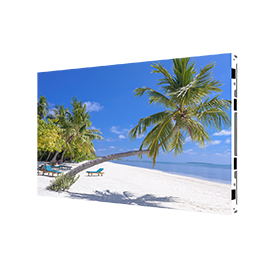Comparision Between Smd And COB LED Displays
SMD LED Display:
Pixel Density: SMD (Surface Mounted Device) LED displays offer higher pixel density due to the smaller size of individual LED components. This allows for better resolution and image quality, especially at shorter viewing distances. SMD displays are suitable for applications where fine details and sharp visuals are crucial, such as high-resolution signage or displays used in events and conferences.
Color Accuracy: SMD LEDs provide better color accuracy and reproduction. The individual LED chips used in SMD technology can produce a wide color gamut, resulting in more vibrant and true-to-life images. This makes SMD LED displays ideal for applications that require accurate color representation, such as advertising and broadcast.
Brightness and Viewing Angle: SMD LED displays typically offer higher brightness levels, ensuring good visibility even in bright outdoor environments. They also provide wider viewing angles, allowing the content to be clearly seen from various positions. This makes SMD displays suitable for outdoor advertising boards, billboards, and large video walls.
Heat Dissipation and Lifespan: SMD LED displays have better heat dissipation capabilities due to their smaller size and efficient packaging. This reduces the risk of overheating and ensures a longer lifespan for the display. It also enables the use of higher power LEDs, resulting in brighter and more energy-efficient displays.
COB LED Display:
Cost-effectiveness: COB (Chip on Board) LED displays are typically more cost-effective compared to SMD LED displays. The packaging of multiple LED chips on a single substrate or PCB reduces the overall manufacturing cost. This makes COB displays a popular choice for applications where cost is a determining factor, such as indoor digital signage for small businesses.
Uniformity: COB LED displays provide better uniformity of light output as multiple LED chips are closely packed together within a single package. This reduces the appearance of individual pixels and creates a more seamless viewing experience. COB displays are suitable for large-scale video walls or displays that require smooth visual transitions.
Power Efficiency: COB LED display screens generally consume less power compared to SMD displays. The integration of multiple LED chips within a single package improves power efficiency, resulting in energy savings. This makes COB displays suitable for applications where power consumption is a concern, such as broadcasting studios or control rooms that require continuous operation.
Reliability: COB LED products are known for their robustness and reliability. The integration of multiple LED chips on a single substrate reduces the chances of individual LED failures, ensuring consistent performance over time. This makes COB displays suitable for mission-critical applications that require high reliability, such as airport information displays or command center video walls.
In conclusion, SMD LED displays offer higher pixel density, better color accuracy, and brighter outputs, making them suitable for applications where image quality and visual impact are crucial. On the other hand, COB LED displays provide cost-effectiveness, uniform light output, and excellent reliability, making them ideal for applications where cost, uniformity, and long-term performance are essential considerations. The choice between the two depends on specific application requirements, budget constraints, and desired performance.
Hot News
-
Digital Exhibition Hall Solution
2024-03-26
-
Command Center Display Solution
2024-03-26
-
Conference Room Display Solution
2024-03-26
-
FAQ
2024-03-06
-
COB Display Solution For Education
2024-03-06

 EN
EN
 AR
AR
 BG
BG
 HR
HR
 CS
CS
 DA
DA
 NL
NL
 FI
FI
 FR
FR
 DE
DE
 EL
EL
 IT
IT
 JA
JA
 KO
KO
 NO
NO
 PL
PL
 PT
PT
 RO
RO
 RU
RU
 ES
ES
 SV
SV
 IW
IW
 ID
ID
 LT
LT
 SR
SR
 SK
SK
 SL
SL
 UK
UK
 VI
VI
 SQ
SQ
 GL
GL
 HU
HU
 TH
TH
 FA
FA
 MS
MS
 AZ
AZ
 KA
KA
 BN
BN
 LA
LA
 MN
MN


